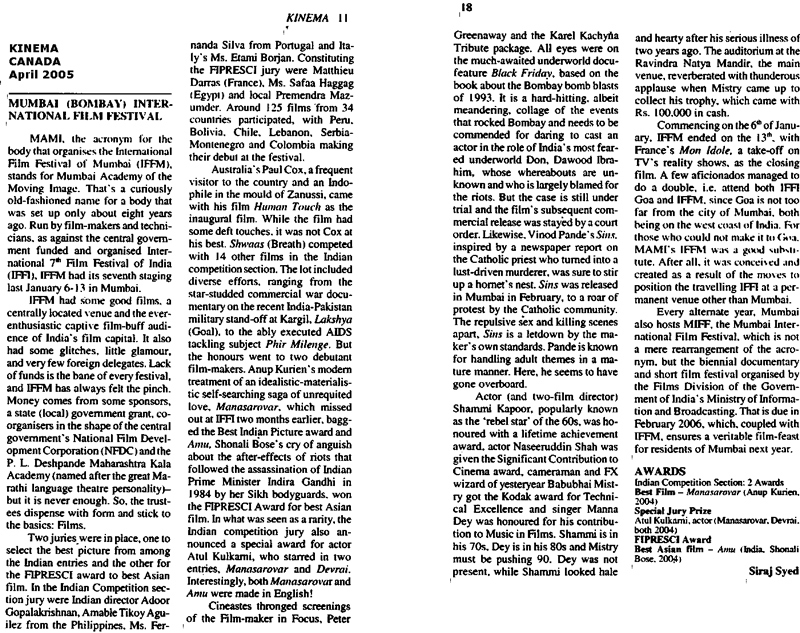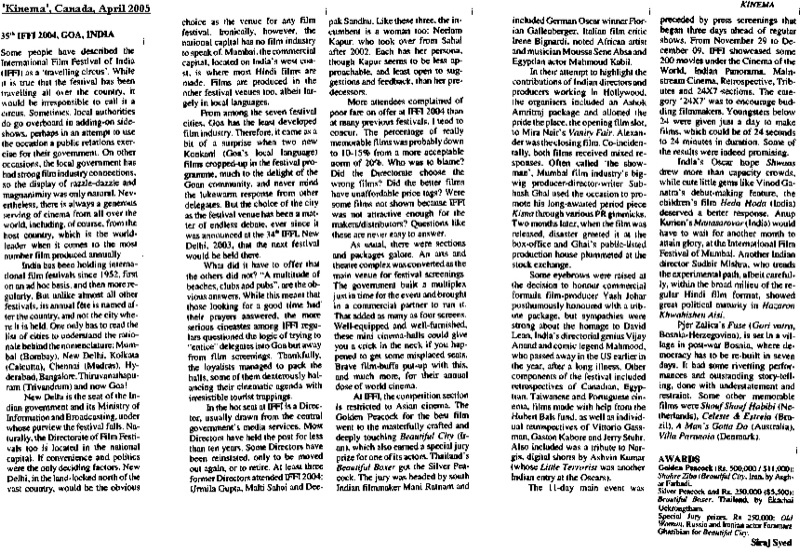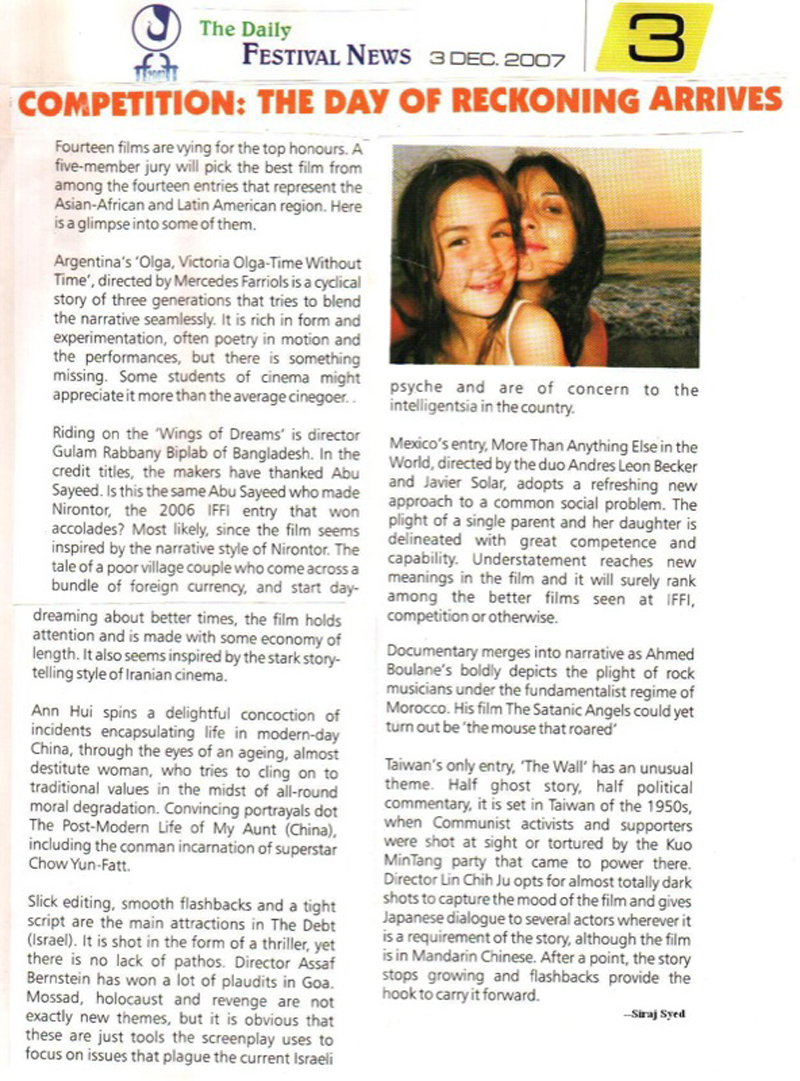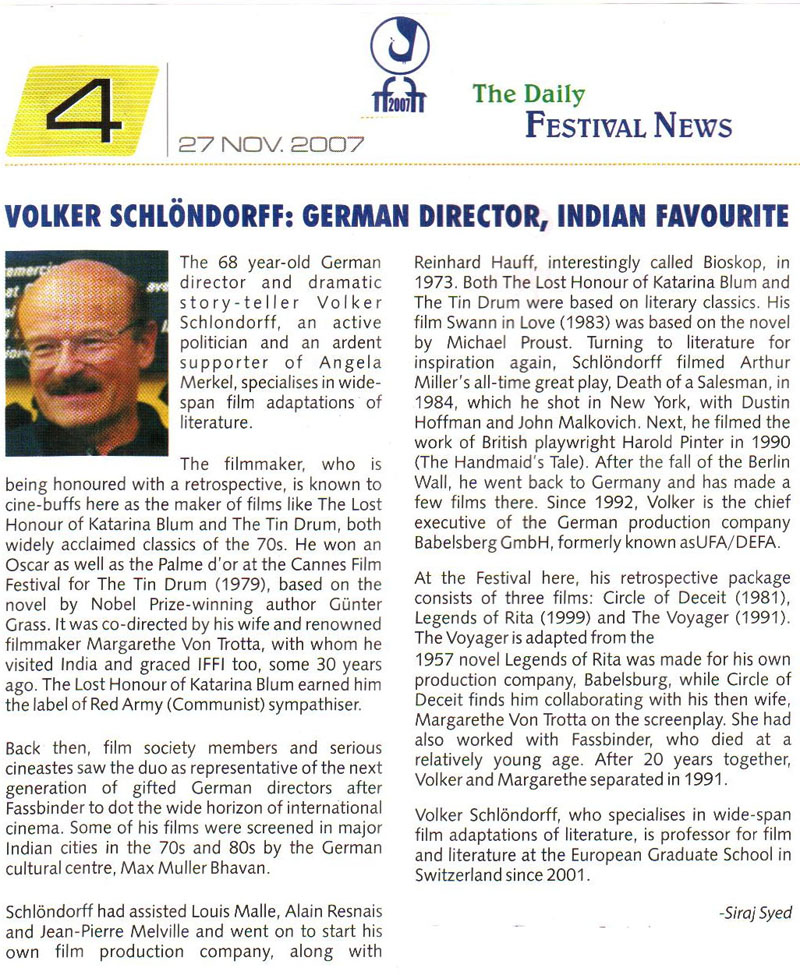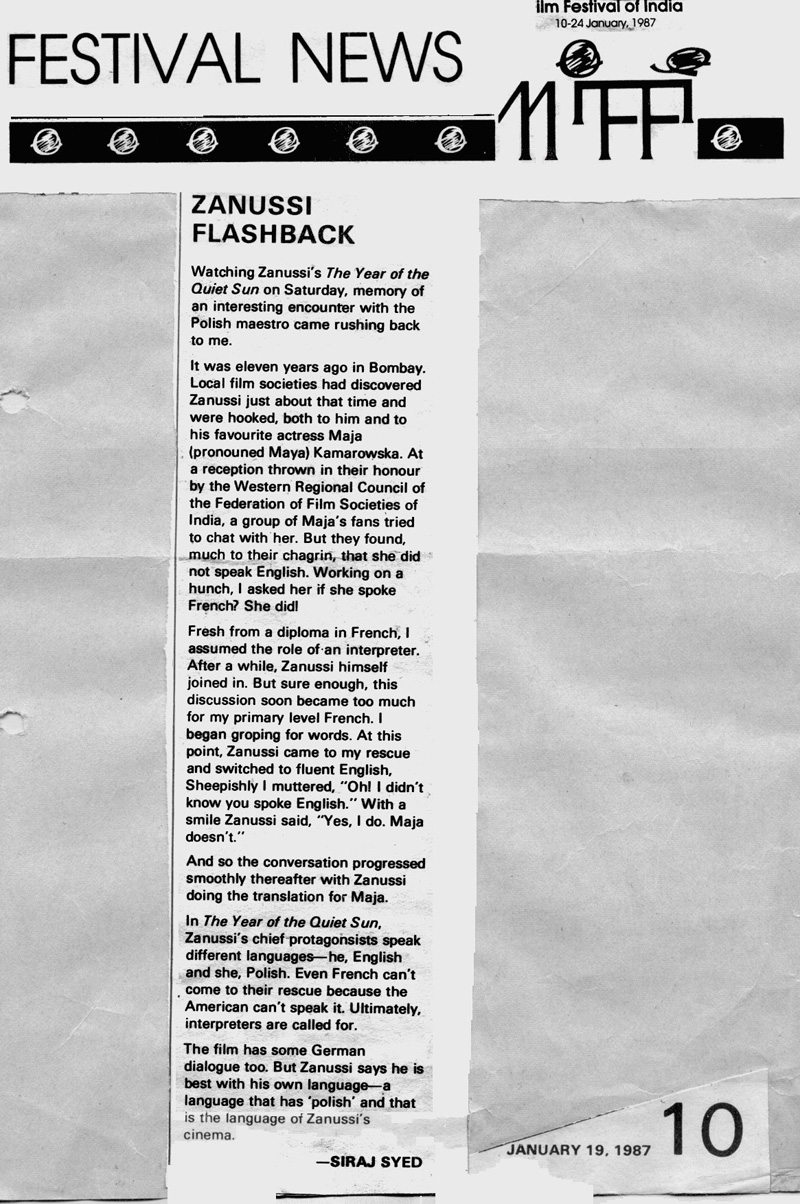|
|
||
|
Pro Tools
FILMFESTIVALS | 24/7 world wide coverageWelcome ! Enjoy the best of both worlds: Film & Festival News, exploring the best of the film festivals community. Launched in 1995, relentlessly connecting films to festivals, documenting and promoting festivals worldwide. We are currently working actively to upgrade this platform, sorry for the inconvenience. For collaboration, editorial contributions, or publicity, please send us an email here. User login |
Siraj SyedSiraj Syed is the India Correspondent for FilmFestivals.com and a member of FIPRESCI, the International Federation of Film Critics. He is a Film Festival Correspondent since 1976, Film-critic since 1969 and a Feature-writer since 1970. He is also an acting and dialogue coach. @SirajHSyed  Nanda’s first death anniversary: One Nanda-less year, plentiful legacy, nonetheless
Nanda’s first death anniversary: One Nanda-less year, plentiful legacy, nonetheless March has its Ides in Shakespeare. In the life of the Karnataki family, it has two significant dates. Jayprakash Karnataki was born on the 14th. His older sister, Nanda, died on the 25th. Born Nandini Winayak Karnataki, on 08 January 1941, today is her first anniversary, and the first time Jayprakash did not get her gift of Rs. 5,000 to buy a new shirt, wear it and show it to his loving sister on the occasion of Gudi Padwa, the Maharashtrian New Year, as was the routine. To try and help heal his wounds, one of her best friends, former actress Saira Banu (married to India’s most adored actor Dilip Kumar), a close friend of the Karnatakis in general and of Nanda in particular, gave that gift. Choked with emotion, Jay made her his raakhee sister (bound by a decorative thread, tied at the wrist, according to Hindu tradition). March has also proven to be a testing time on the health front, with Jay undergoing operations and extensive treatment of his legs and back. But ask him about Nanda and the excruciating pain subsides, and memories overflow. Their father was actor-producer-director Master Winayak (Karnataki), and mother, Meenaxi (also known as Susheela, not to be confused with actress Meenaxi Shirodkar; Mrs. Karnataki never worked in films). Winayak used to make bilinguals, in Hindi and Marathi languages. One of his best was Brahmachari. He had eight children, only two survive today; Jayprakash, and an older brother, who recently retired as an aeronautical engineer in an airline. Both live in Mumbai. Meena, three years older than Nanda, was married to producer C.V.K. Sastry. Jayprakash is a director of ads, corporate films, video films, TV serials and Hindi and Marathi feature films. Her father died in 1947, aged 41, when Nanda was six years old. Nanda’s family pet name was N’na.
Winayak introduced Lata Mangeshkar as playback singer and also made her act in his films, usually bit roles, as a sister. In 1947, when he was making a film called Mandir, Lata told him that she would not act anymore and concentrate entirely on her singing. Winayak asked Nanda to act in Mandir, when she was about five-six. She was not interested at all, but her mother persuaded her. Her words: “This is the first and the last time I will face a camera.” Words that would prove to be anything but prophetic. Winayak cast her as the son of the lead pair, naming her Baby Nanda. She was about 8 when the film released. This was Master Winayak’s last film, released after his death. Marathi film-makers were impressed by her performance, and she was cast in several Marathi films as well as Hindi films, like Angaarey, Jaggu, Krishna Sudama and Jagadguru Shankaracharya, during 1948-57. Initially, she did not like wearing traditional Maharashtrian sarees, because she was barely a teenager, and studied at an English medium school. Her paternal step-uncle, famous producer-director-actor V. Shantaram, who had made a few films with Winayak as, first, a supporting actor and then the hero (Shantaram was highly impressed by this learned Kolhapuri lad who had great command over English). He gave her the central female role in Toofan Aur Diya. It was the saga of an orphaned brother and sister pair, and the sister goes blind. Once there was a wedding at V. Shantaram's place. He called-up Nanda’s elder sister Meena, and requested her to bring Nanda for the marriage, dressed in a saree. In the middle of the party, Shantaram told Meena, "She is the heroine of my next film." She received her first Filmfare Award nomination as Best Supporting Actress for Bhabhi (1957) and won it for Anchal (1960), acting as a fun-loving tomboy. In what was to haunt her all her life, none of her later, and even better performances, won her any awards, though many bagged nominations. She played a supporting role in Dev Anand’s Kala Bazar (which made her lifelong friends with Waheeda Rehman, her closest friend till the end), and played second lead in B. R. Chopra’s Dhool Ka Phool.
Nanda played the title role in L.V. Prasad's Chhoti Bahen (1959). The movie was a big hit, making her a star, and also attracting the tag of the perennial Chhoti Bahen (younger sister). In this film, Nanda played the blind younger sister, looked after by two elder brothers, Balraj Sahni and Rehman. She then played lead roles, such as one of Dev Anand’s two heroines in Hum Dono (Dev had a double role) and one of his three heroines in Teen Devian (Simi and Kalpana were the other two). She was the heroine in B R Chopra's court-room drama, Kanoon (1960), a film with no songs, which was, then, very rare. Acclaimed producer, director and actor Raj Kapoor knew Master Winayak very well. When he was making Boot Polish, back in the 50s, he auditioned a lot of child artistes for the film, including Baby Tabassum, Baby Naaz and Baby Nanda. After the screen test, he called her over, spoke high about her father and then lamented, "Sorry, I can't take you in the film because in no way do you look like a beggar." (The film was about street children and beggars). She was paired with Raj Kapoor in Aashiq (1962). Raj Kapoor advised her strongly against accepting this role, since he felt she was goody two-shoes, and the part was full of negative shades. Padmini played the heroine. As was her wont, Nanda refused to cow down and performed with élan. After seeing the last shot at the première, Kapoor said, “I stand corrected. With one look and one line, you have become the heroine and Raj Kapoor has become the villain of the piece.” At the twilight of her film career, she met Raj Kapoor at Yash Johar's party, held at her best friend, Waheeda Rehman's house. Kapoor asked her whether she would work in his next film. She thought he was joking and said “Yes”. To her surprise, she got a call from Raj a few days later. He said, "According to me, you would fit the role of Chhoti Bahu in my film. Will you do it?" he asked. "Not before I read the script," Nanda answered. The next day, she found Jainendra Jain, with the script, in her house. After going through the script, she did the role in Kapoor’s Prem Rog.
She worked with Rajendra Kumar in three films - Toofan Aur Diya (1956), Dhool Ka Phool (1961) and Kanoon (1960). With Shammi Kapoor, she did Prem Rog (opposite Kulbhushan Kharbanda), in 1982. Many of her great performances were in films that failed or did average business, like Usne Kaha Tha (Sunil Dutt), Char Diwari (Shashi Kapoor), Nartaki (Sunil Dutt), and Aaj Aur Kal (Ashok Kumar and Sunil Dutt), she used to lament, justifiably. Nanda usually agreed to act opposite newcomers or unsuccessful heroes. She did several films with Shashi Kapoor, Raj Kapoor’s younger brother, at a time when he was yet to become successful. Their first two films were Char Diwari (1961) and Mehndi Lagi Mere Haath (1962). In Jab Jab Phool Khile (1965, Shashi again), Nanda played a Westernised role for the first time. Other films of the pair are Mohabbat Isko Kehte Hain (1965), Neend Hamari Khwab Tumhare (1966), Juari (1968), Raja Saab (1969) and Rootha Na Karo (1970). Jab Jab Phool Khile was remade as Raja Hindustani, starring Aamir Khan and Karisma Kapoor, Shashi’s grand-niece. Some other Nanda traits that are rare among film-stars: She did not charge a producer for any incidental expenses incurred during shooting. Even her 4 o’clock cold-drink was paid for by her. The joke that went around was: producers were feeling that she was not treating them well, by NOT making demands from them, not even having a cup of coffee on their account. Food, too, obviously, came from her home. If a film was shelved or if it did not proceed beyond its launch, Nanda returned the payment she had received.
Rajendra Kumar used to strongly advise Nanda against accepting negative or glamorous roles, insisting that her persona was just not made for it. As it transpired, in the near future, Rajendra Kumar was backing a film called The Train, a slick thriller full of Western music and dances. Nanda suggested to Rajendra Kumar, to take Rajesh Khanna as the main lead, since she had seen him in Raaz. When Raaj Kumar turned down the Ittefaq role, Nanda again suggested Rajesh Khanna to the Chopras, being impressed by his work in The Train. In the film Ittefaq, she is apparently a good woman, but turns out to be the vamp. It was perhaps one of her most negative roles, and even producer B.R. Chopra was having qualms when the grist mill got working to create an unfavourable atmosphere about the ‘crazy’ casting. But right from the first shot, it was made clear on screen that audiences were to expect not the Nanda of Chhoti Bahen or Badi Didi, but a new, sensual, ‘criminally inclined’ actress. Again, it was Nanda who recommended Sanjeev Kumar to Mehmood for Pati Patni, having seen some of his work. In 1965, Gumnaam (Manoj Kumar) helped put her in the top league of heroines. With Dharmendra, she worked in Mera Kasoor Kya Hai and Akashdeep (also starring Nimmi, wherein she did a hilarious Pathan act). She played single heroine from 1958-59, and continued to get roles as the main female lead till 1973, for some 15 years. Joroo Ka Ghulam (1972) was a comedy with Rajesh Khanna. She acted opposite Jeetendra, in films like Parivar and Dharti Kahe Pukar Ke; with Sanjay Khan, she had Beti and Abhilasha. Interestingly, she had already done the sister’s role with Mehmood when they were paired romantically in Qaidi No. 911. Mehmood treated her like a real sister, calling her “Chhoti,” and felt embarrassed to act as her lover and sing romantic songs with her on screen. After a small role in actor-director Manoj Kumar's Shor (1972), for which she did not charge a paisa, Nanda did few more films, such as Chhalia (1973, Navin Nischol, Shatrughan Sinha), Naya Nasha (1973 and produced by her behnoi, her sister Meena's husband, C.V.K. Sastry). She then stopped acting. It broke her heart that her most hard-worked and complex performance could not save the film. In 1982, she came back with three major films, all coincidentally having her play Padmini Kolhapure's mother: Ahista Ahista, Mazdoor and Prem Rog. Then, she permanently retired. Nanda used to watch thespian Dilip Kumar’s films like Kohinoor and Devdas and rave about him. Both he and Saira took lot of care of Nanda, and stood by her when she was in the midst of bad times. She only did one film with Dilip Kumar: Mazdoor. In 1965, a Maharashtrian lieutenant colonel was smitten by Nanda and had asked a producer to forward his marriage proposal to her mother. In the end, nothing came of it. Nanda's brothers brought home many suitors for her, but she turned them all down. In 1992, a middle-aged Nanda got engaged to producer-director Manmohan Desai, at the urging of Waheeda Rehman, and, would you believe it, Desai’s real son Ketan. Her affair with Manmohan Desai was short-lived, as, within two years after their engagement on June 18, 1992, Desai expired, in 1994. Desai and Nanda never worked together. Nanda’s mother had cancer, and died in 1993. The Nanda-Manmohan Desai marriage was held back, as a mark of respect to the demise. Nanda never married.
Manmohan was a huge Nanda fan since he was a teenager. When he turned director, his first choice was Nanda, but she would not give him the time of day. One reason was the hero of these films, Shammi Kapoor (Shammi’s daughter Kanchan later married Ketan). Nanda was very wary of the rebel star, who was known to be bold and flirtatious. Desai could not get beyond ‘gatekeeper’ Meena. After Bluff Master and Budtameez, he made one last attempt by offering her Kismet. It was still a “No.” It would remain a No for the next twenty years, till, one day, Ketan would tell his widower father that it would be good idea if he considered re-marrying, since he was extremely lonely. Ketan’s mother was look-alike of Nanda, and that was a primary reason why Manmohan had married her. In came Waheeda and another friend, Yash Johar (producer, father of Karan), a dinner was organised, and three words flowed from Manmohan’s lips to Nanda’s ears. In return, he was relieved to hear a reply that had three characters, not two, “Yes.” After Manmohan’s passing away, she wore only white (a widow’s dress), refused to meet anybody who might even remotely be perceived as nursing a desire to propose matrimony (“I am married in spirit and soul”) and strongly avoided the media, except at Desai’s death itself. In the last few years, Nanda inter-acted only with family and close friends: Waheeda Rehman, Saira Banu, Asha Parekh, Helen, Mala Sinha, Shakeela and Jabeen Jaleel. Jayprakash got a call every morning at 9.15 am, and he, in turn, called her at night, just before she went to sleep. Her dinner time was 7 pm. The only place where she was seen visiting was the residence of the couple Dilip Kumar and Saira Banu. After a long time, she made a public appearance with Waheeda Rehman for a screening of the Marathi film Natarang (2010). She was very fond of cooking. Many writers approached her to write her biography, but she turned them down.
Waheeda advised her to sleep with her bedroom door ajar, as anything could happen at this age, and locking the door would make it difficult to get help in an emergency. Nanda took her advice. Her man-Friday, Prasad, discovered her dead at around 9 am, because he got suspicious at not finding her awake at her usual hour of 7 am. A doctor was supposed to visit her that afternoon, to check a persistent pain in her jaw. But she was already dead by then, having passed away in her sleep, of a massive heart attack. She had no history of heart disease.
It was her one great wish to die without hospitalisation, and it came true. On hearing that Jay was going to pay obeisance at the shrine of Shirdi Sai Baba, she told him to pray that she should ‘go’ without being admitted to a hospital, a wish that he feels was granted by the blessings of the Godman. After death, she wanted no condolence meet and wanted her ashes to be immersed at Banganga, in Mumbai, instead of the family tradition of immersing them into the holy rivers at Nashik, some 3-4 hours’ drive from Mumbai. She did not want a big funeral or a condolence meet. Jay honoured her wishes. Among the various things Jay and his family (actress/danseuse Jayshree T. and son Swastik) have done to keep her memory alive is the printing of a special calendar with her pictures and his thoughts. He gracefully gave me a copy. I think I deserved one. For did I not visit her year after year in the 70s and 80s on her birthday, with a red rose in my hand? The smile on her face as she accepted the flower floods my thoughts every time she is mentioned. It has been one whole Nanda-less year, in terms of her physical absence. Nonetheless, her innate charm sustains, and her legacy is plentiful. 24.03.2015 | Siraj Syed's blog Cat. : Dilip Kumar First death anniversary Jab Jab Phool Khile Jayprakash Karnataki Manmohan Desai Master Winayak Nanda Saira Banu V. Shantaram PEOPLE
|
LinksThe Bulletin Board > The Bulletin Board Blog Following News Interview with EFM (Berlin) Director
Interview with IFTA Chairman (AFM)
Interview with Cannes Marche du Film Director
Filmfestivals.com dailies live coverage from > Live from India
Useful links for the indies: > Big files transfer
+ SUBSCRIBE to the weekly Newsletter DealsUser imagesAbout Siraj Syed Syed Siraj Syed Siraj (Siraj Associates) Siraj Syed is a film-critic since 1970 and a Former President of the Freelance Film Journalists' Combine of India.He is the India Correspondent of FilmFestivals.com and a member of FIPRESCI, the international Federation of Film Critics, Munich, GermanySiraj Syed has contributed over 1,015 articles on cinema, international film festivals, conventions, exhibitions, etc., most recently, at IFFI (Goa), MIFF (Mumbai), MFF/MAMI (Mumbai) and CommunicAsia (Singapore). He often edits film festival daily bulletins.He is also an actor and a dubbing artiste. Further, he has been teaching media, acting and dubbing at over 30 institutes in India and Singapore, since 1984.View my profile Send me a message The EditorUser contributions |

























